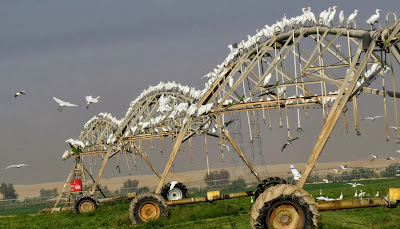Though little crake is believed to be only a passage bird in central Arabia, I set out on Friday morning to see if I could find a crake in the same area as Lou had 6 days before.
However before I set about heading towards the right part of Al Hayer I was distracted by a very large number of cattle egret in one of the pivot fields.
some of over 400 cattle egret
The grass had just been cut and the cattle egret were clearly attracted to this as I have seen elsewhere before. On Friday though, I counted over 400.
a single squacco heron
During most of the year squacco heron are the most common member of the heron family but on Friday morning I found just one on the edge of the field.
blue-cheeked bee-eater
The field was not just crowded with cattle egret. Many Barn swallow were once again hawking for insects. I am beginning to wonder when their passage will end. More surprisingly 40 blue-cheeked bee-eater were doing the same.
a row of blue-cheeked bee-eaters
This is not only another late passage but also the largest flock of the species I have seen this autumn. I can only assume it's been milder than usual in the Caucacus and Central Asia for this time of year.
an adult male marsh harrier
The field also attracted three marsh harrier. One was an adult male which is very uncommonly seen in this parts.
kestrel
The only other birds of prey in the early morning in the field were two kestrel.
white wagtail taking off
White wagtail wintering numbers are picking up and there were tens in the same field. I didn't inspect any other pivot field because the fields weren't meant to be my primary destination on Friday. No yellow wagtail remain from earlier this autumn.
Indian silverbill
Some times of year the fields are swarming with sparrows, finches, weavers and allies. This time Indian silverbill and a small number of Spanish sparrow were all that could be seen in the field with the cattle egret and the only one that I searched.
Tree pipit
Of the other smaller birds, a few tree pipit are still making there way through.
Siberian stonechat
adult little bittern
Other birds seen in the pivot field area were collared dove, laughing dove, Namaqua dove, little green bee-eater, crested lark, black bush robin, house sparrow, moorhen, purple heron and grey heron.
The last two birds I saw before setting off down the water course and away from the pivot fields on my quest for crakes was a resting little bittern and a red avadavat that flew over.
I'll write next about how I got on during the rest of the morning looking for little crake.












Hi Rob,
ReplyDeleteIsn't the BC Night Heron a Little Bittern?
Andrew B
Andy, It is! and its a better bird! I blog too quickly. I have changed the caption.
ReplyDeleteRob